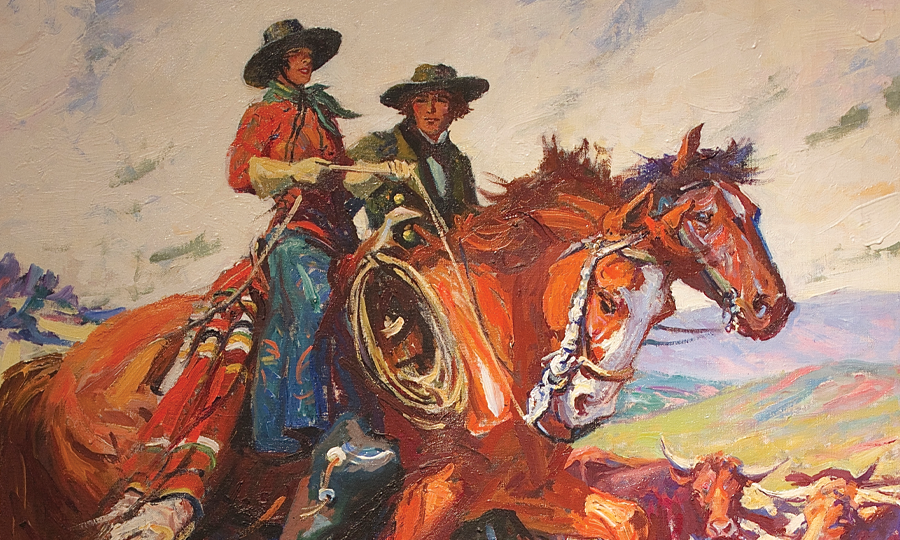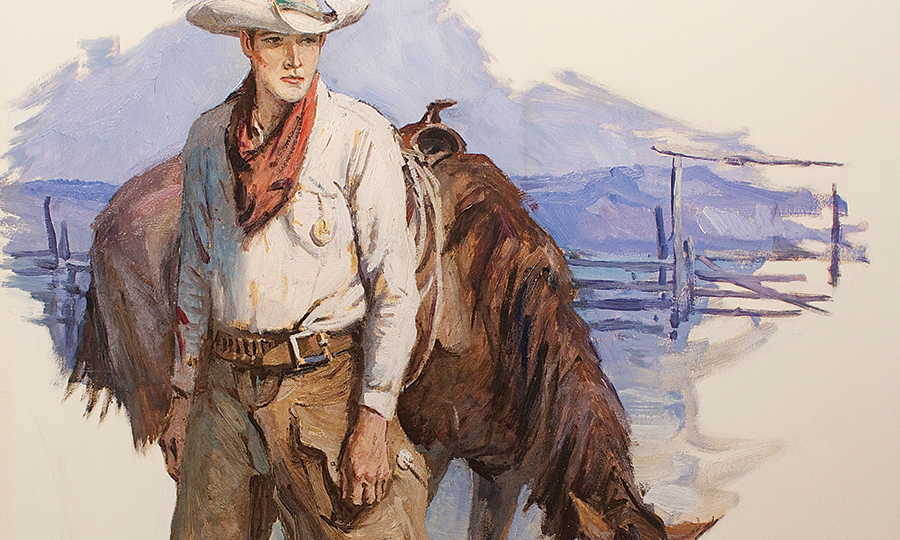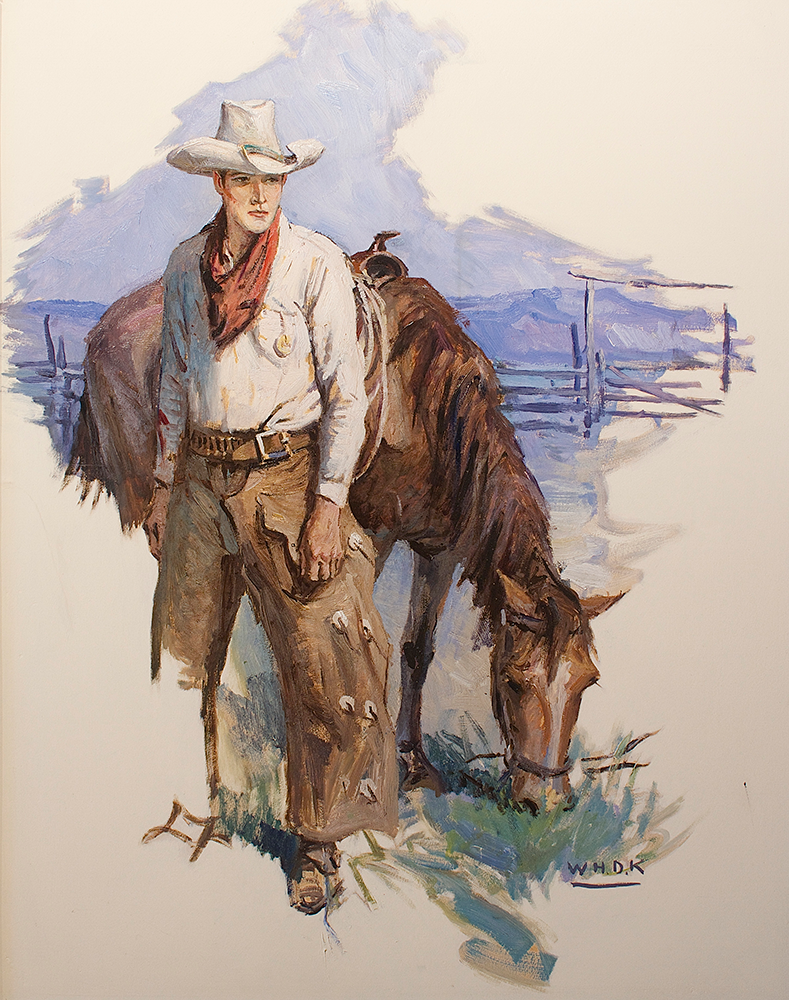W. H. D. Koerner
William Henry Dethlef Koerner is renowned as one of the master illustrators of America's Wild West, ranking with Frederic Remington, Charles M.
Russell, Phillip R. Goodwin, and Harvey Dunn.
Koerner's illustrations are known for his bold brushwork with a vibrant color palette which enabled his vigorous depictions of the 'Great American West,' emblemic images of those untamed territories.
Born in Lunden, Holstein, Germany, Koerner with his parents immigrated to Clinton, Iowa when he was three years old. Although he had little art training as a youth, his raw talent was always obvious to his parents and to everyone who viewed his sketches.
At the age of twenty, Koerner was hired by the Chicago Tribune as a staff artist at $5 per day, quite a respectable income in 1898. Shortly thereafter, he married and accepted a job as art editor for a brand new newspaper, the United States Daily. Unfortunately, that newspaper was shortlived, and as such, the young couple decided that New York could not survive without them and they moved east.
Once established in New York, Koerner was hired by Pilgrim Magazine to cover the 1904 St. Louis Exposition, it was then that he realized that he needed proper instruction to succeed further in his chosen field. He enrolled at the Art Students League for a two-year program between 1905-07, under the venerable George Bridgman, Norman Rockwell's teacher.
A student colleague later persuaded Koerner to apply to Howard Pyle's illustration school in Wilmington. Koerner's exposure to Howard Pyle was significant, but his student colleagues also had much to offer and he shared techniques and styles with of N. C. Wyeth, Harvey Dunn, Frank Schoonover and Stanley Arthurs.
While still a Pyle student, he rented a studio adjacent to Anton Otto Fischer and William Foster, and the interaction between these talented students proved mutually invaluable.
Howard Pyle passed away in 1911, and Bill Koerner was honored to write a eulogy tribute to his beloved mentor, and it was published in the New Amstel Magazine. A year later, the first exhibition by Pyle's students was presented to the public, and Koerner's works figured prominently, standing out amongst very strong competition.
In 1919, the Saturday Evening Post art editor invited Koerner to illustrate two articles with Western themes which proved to be a major turning point in his life. The articles, "The Covered Wagon" and "Traveling the Old Trails" entailed many Western frontier scenes, which up to that point, he had not experienced. Immediately Koerner thrust himself into researching the correct depictions of things totally unfamiliar.
The West immediately captured his imagination and captivated his soul and as a result, he dove into it's history, tools and weapons, livestock and wildlife, architecture and building types and the eccentric characters who inhabited the plains and mountains. In the process, WHD Koerner became one of the best-known artists of the old West. He learned more about the visual elements than most seasoned cowboys could articulate and went to gain more knowledge of the authentic way to picture the West.
Trips with his family ensued as reconnaissance journeys to absorb the atmosphere in order to better portray reality. Ultimately, his paintings were imbued with an ambience true to the territories he was depicting, just as Pyle had taught.
From 1922 onwards, Koerner illustrated more than two-hundred and fifty stories with Western themes and painted over six hundred pictures for periodicals. He illustrated a number of books including those by author, Zane Grey (The Drift Fence and Sunset Pass) and Eugene M. Rhodes's classic, Paso Por Aqui. Overall it is assumed that he completed nearly two-thousand illustrations of which about eighteen hundred were done for magazines, as well as advertisements for C. W. Post 's Grape-Nuts and Postum cereals.
In 1924, the Koerner family took a trip to Montana where his fame for Wild West paintings had grown widespread and he was received 'home' as a local cowboy. American's always loved the notion of the frontier and a rugged lifestyle of independence. Koerner was one of the first to portray it accurately for mass consumption.
It is not surprising to learn that Maxfield Parrish was a great influence on Koerner and his use of color. Parrish illustrated "The Great Southwest" articles by Raymond Stannard Baker which appeared in Century Magazine. In those western landscapes Parrish burst forth with bold colors used in a way which had not been done before. The
colors seemed unreal and even surreal; pure oranges, cobalt blue and purple skies, red suns with cadmium streams of light-a vision to behold and the Parrish images, like the West itself, captivated Bill Koerner.
A prolific and versatile artist-illustrator, 'Big Bill' Koerner's work gained considerable visibility through his cover and story illustrations for the Saturday Evening Post, The Ladies' Home Journal, Harper's, McClure's Magazine and Red Book. He died in 1938 at fifty-eight, having been seriously ill and unable to paint for three years prior.©2004 Natioanl Museum of American Illustration, www.americanillustration.org
Russell, Phillip R. Goodwin, and Harvey Dunn.
Koerner's illustrations are known for his bold brushwork with a vibrant color palette which enabled his vigorous depictions of the 'Great American West,' emblemic images of those untamed territories.
Born in Lunden, Holstein, Germany, Koerner with his parents immigrated to Clinton, Iowa when he was three years old. Although he had little art training as a youth, his raw talent was always obvious to his parents and to everyone who viewed his sketches.
At the age of twenty, Koerner was hired by the Chicago Tribune as a staff artist at $5 per day, quite a respectable income in 1898. Shortly thereafter, he married and accepted a job as art editor for a brand new newspaper, the United States Daily. Unfortunately, that newspaper was shortlived, and as such, the young couple decided that New York could not survive without them and they moved east.
Once established in New York, Koerner was hired by Pilgrim Magazine to cover the 1904 St. Louis Exposition, it was then that he realized that he needed proper instruction to succeed further in his chosen field. He enrolled at the Art Students League for a two-year program between 1905-07, under the venerable George Bridgman, Norman Rockwell's teacher.
A student colleague later persuaded Koerner to apply to Howard Pyle's illustration school in Wilmington. Koerner's exposure to Howard Pyle was significant, but his student colleagues also had much to offer and he shared techniques and styles with of N. C. Wyeth, Harvey Dunn, Frank Schoonover and Stanley Arthurs.
While still a Pyle student, he rented a studio adjacent to Anton Otto Fischer and William Foster, and the interaction between these talented students proved mutually invaluable.
Howard Pyle passed away in 1911, and Bill Koerner was honored to write a eulogy tribute to his beloved mentor, and it was published in the New Amstel Magazine. A year later, the first exhibition by Pyle's students was presented to the public, and Koerner's works figured prominently, standing out amongst very strong competition.
In 1919, the Saturday Evening Post art editor invited Koerner to illustrate two articles with Western themes which proved to be a major turning point in his life. The articles, "The Covered Wagon" and "Traveling the Old Trails" entailed many Western frontier scenes, which up to that point, he had not experienced. Immediately Koerner thrust himself into researching the correct depictions of things totally unfamiliar.
The West immediately captured his imagination and captivated his soul and as a result, he dove into it's history, tools and weapons, livestock and wildlife, architecture and building types and the eccentric characters who inhabited the plains and mountains. In the process, WHD Koerner became one of the best-known artists of the old West. He learned more about the visual elements than most seasoned cowboys could articulate and went to gain more knowledge of the authentic way to picture the West.
Trips with his family ensued as reconnaissance journeys to absorb the atmosphere in order to better portray reality. Ultimately, his paintings were imbued with an ambience true to the territories he was depicting, just as Pyle had taught.
From 1922 onwards, Koerner illustrated more than two-hundred and fifty stories with Western themes and painted over six hundred pictures for periodicals. He illustrated a number of books including those by author, Zane Grey (The Drift Fence and Sunset Pass) and Eugene M. Rhodes's classic, Paso Por Aqui. Overall it is assumed that he completed nearly two-thousand illustrations of which about eighteen hundred were done for magazines, as well as advertisements for C. W. Post 's Grape-Nuts and Postum cereals.
In 1924, the Koerner family took a trip to Montana where his fame for Wild West paintings had grown widespread and he was received 'home' as a local cowboy. American's always loved the notion of the frontier and a rugged lifestyle of independence. Koerner was one of the first to portray it accurately for mass consumption.
It is not surprising to learn that Maxfield Parrish was a great influence on Koerner and his use of color. Parrish illustrated "The Great Southwest" articles by Raymond Stannard Baker which appeared in Century Magazine. In those western landscapes Parrish burst forth with bold colors used in a way which had not been done before. The colors seemed unreal and even surreal; pure oranges, cobalt blue and purple skies, red suns with cadmium streams of light-a vision to behold and the Parrish images, like the West itself, captivated Bill Koerner.
A prolific and versatile artist-illustrator, 'Big Bill' Koerner's work gained considerable visibility through his cover and story illustrations for the Saturday Evening Post, The Ladies' Home Journal, Harper's, McClure's Magazine and Red Book. He died in 1938 at fifty-eight, having been seriously ill and unable to paint for three years prior.©2004 Natioanl Museum of American Illustration, www.americanillustration.org

LOOKING FOR A SPECIFIC PIECE?
We would be pleased to assist you in locating a western artist or Indian piece that you are particularly interested in. Contact us today to begin the search for your next piece.
CONTACT THE GALLERY










